March 2020 global temperature second warmest on record

Courtesy of Pixabay.com
https://www.ncei.noaa.gov/news/global-climate-202003
The globally averaged temperature departure from average over land and ocean surfaces for March 2020 was the second highest for the month in the 141-year NOAA global temperature dataset record, which dates back to 1880.
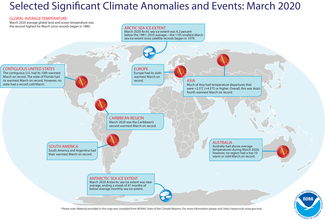
This monthly summary, developed by scientists at NOAA National Centers for Environmental Information, is part of the suite of climate services NOAA provides to government, business, academia and the public to support informed decision-making.
Temperature
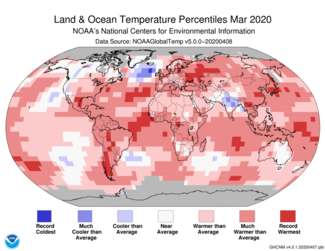
The March 2020 global land and ocean surface temperature was 2.09°F (1.16°C) above the 20th century average of 54.9°F (12.7°C). This was the second highest for March in the 141-year record and tied with February 2020 and December 2015 as the third highest monthly temperature departure from average in the 1,683-month record. Only February and March 2016, when a strong El Niño was present in the tropical Pacific Ocean, had higher temperature departures.
- March 2020 marked the 44th consecutive March and the 423rd consecutive month with temperatures, at least nominally, above the 20th-century average.
- March 2016, 2017, 2019 and 2020 were the only Marches with a global land and ocean surface temperature departure from average above 1.8°F (1.0°C). The 10 warmest Marches have all occurred since 1990.
- The most notable warm March temperature departures were observed across much of Asia, the eastern half of the contiguous United States and southern South America, where temperatures were 3.6°F (2.0°C) above average or higher. Some ocean areas were notably warm as well, including parts of the Atlantic Ocean, central Indian Ocean and parts of the northern and southwestern Pacific Ocean, where temperatures were 1.8°F (1.0°C) above average or higher. Meanwhile, the most notable cool temperature departures of −2.7°F (−1.5°C) or cooler were present across Canada, Alaska, northern India, and parts of the North Atlantic Ocean and the Antarctic.
- Record warm March surface temperatures were present across parts of the Atlantic, Indian and western Pacific oceans, as well as parts of southern North America, South America, Asia and Africa. One small area across the North Atlantic had record cold March temperature.
- South America had its warmest March on record, while the Caribbean region had its second warmest March on record.
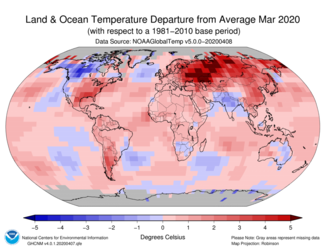
Sea Ice and Snow Cover
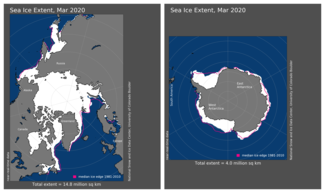
Arctic sea ice extent for March 2020 was 251,000 square miles (4.2 percent) below the 1981–2010 average and the 11th smallest March extent in the 42-year record, according to analysis by the National Snow and Ice Data Center (NSIDC) using data from NOAA and NASA. The Arctic reached its maximum annual extent on March 5 at 5.81 million square miles and was also the 11th smallest annual extent on record.
Antarctic sea ice extent during March 2020 was 1.54 million square miles, which is near the 1981–2010 average. According to the NSIDC, March 2020 ended Antarctica’s 41-month period of below-average monthly sea ice extent.
According to data from NOAA and analyzed by the Rutgers Global Snow Lab, the Northern Hemisphere snow cover extent during March was 930,000 square miles below the 1981–2010 average and the fifth smallest March snow cover extent in the 54-year period of record. The North American snow cover extent was near average, while Eurasia had its fourth smallest March snow cover extent on record.
January–March 2020
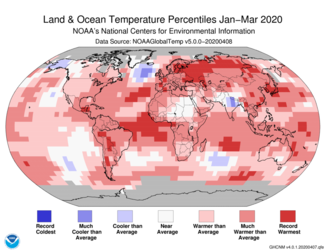
The year-to-date global land and ocean surface temperature was also the second highest in the 141-year record at 2.07°F (1.15°C) above the 20th-century average of 54.1°F (12.3°C). This value is only 0.14°F (0.08°C) less than the record set in 2016.
- Both the Northern and Southern hemispheres had their second warmest January–March period since global records began in 1880, behind the record set in 2016.
- Europe and Asia had their warmest January–March period on record. The Caribbean region and South America had their second and third highest January–March temperature departure from average on record, respectively.
- The first three months of the year had warmer-than-average conditions across much of the globe; the most notable warm January–March temperature departures were observed across much of eastern Europe and Asia, where temperatures were 5.4°F (3.0°C) above average or higher. Meanwhile, the most notable cool temperature departures of −2.7°F (−1.5°C) or cooler were present across Alaska and western parts of Canada.
- Record warm January–March temperatures were present across parts of Europe, Asia, Central and South America, as well as the Atlantic, Indian and western Pacific oceans. However, no land or ocean areas had record cold January–March temperatures.
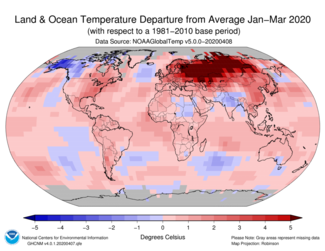
- According to a statistical analysis done by NCEI scientists, the year 2020 is very likely to rank among the five warmest years on record.
For a more complete summary of climate conditions and events, see our March 2020 Global Climate Report.
The post Assessing the Global Climate in March 2020 appeared first on Healthy Indoors.






















